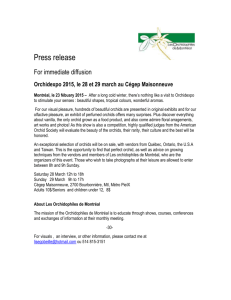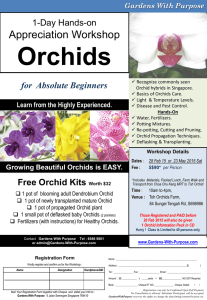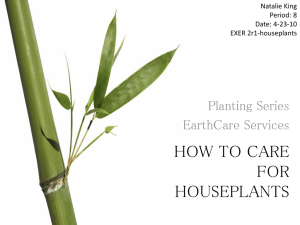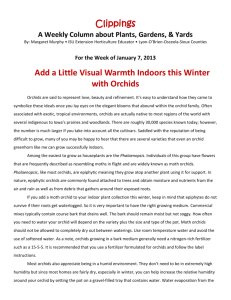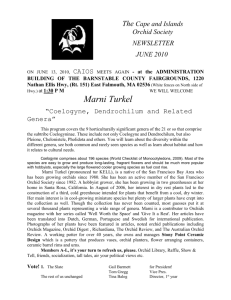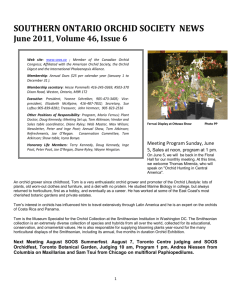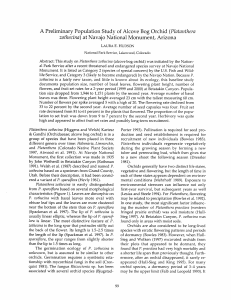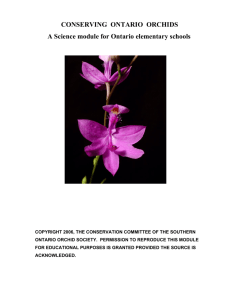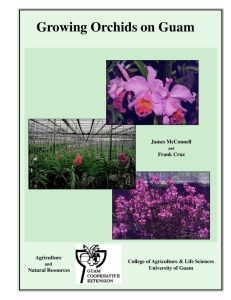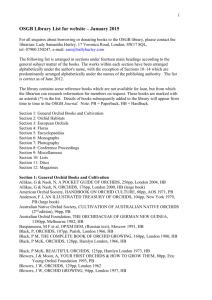Native Pennsylvania Orchids
advertisement
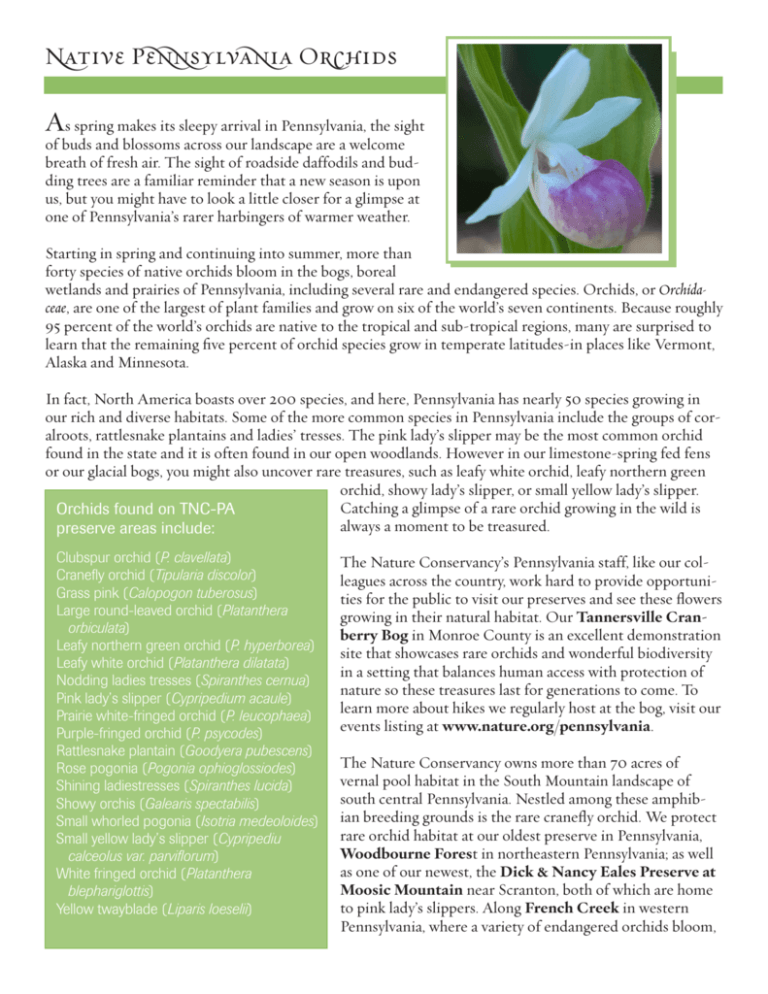
Native Pennsylvania Orchids As spring makes its sleepy arrival in Pennsylvania, the sight of buds and blossoms across our landscape are a welcome breath of fresh air. The sight of roadside daffodils and budding trees are a familiar reminder that a new season is upon us, but you might have to look a little closer for a glimpse at one of Pennsylvania’s rarer harbingers of warmer weather. Starting in spring and continuing into summer, more than forty species of native orchids bloom in the bogs, boreal wetlands and prairies of Pennsylvania, including several rare and endangered species. Orchids, or Orchidaceae, are one of the largest of plant families and grow on six of the world’s seven continents. Because roughly 95 percent of the world’s orchids are native to the tropical and sub-tropical regions, many are surprised to learn that the remaining five percent of orchid species grow in temperate latitudes-in places like Vermont, Alaska and Minnesota. In fact, North America boasts over 200 species, and here, Pennsylvania has nearly 50 species growing in our rich and diverse habitats. Some of the more common species in Pennsylvania include the groups of coralroots, rattlesnake plantains and ladies’ tresses. The pink lady’s slipper may be the most common orchid found in the state and it is often found in our open woodlands. However in our limestone-spring fed fens or our glacial bogs, you might also uncover rare treasures, such as leafy white orchid, leafy northern green orchid, showy lady’s slipper, or small yellow lady’s slipper. Catching a glimpse of a rare orchid growing in the wild is Orchids found on TNC-PA always a moment to be treasured. preserve areas include: Clubspur orchid (P. clavellata) Cranefly orchid (Tipularia discolor) Grass pink (Calopogon tuberosus) Large round-leaved orchid (Platanthera orbiculata) Leafy northern green orchid (P. hyperborea) Leafy white orchid (Platanthera dilatata) Nodding ladies tresses (Spiranthes cernua) Pink lady’s slipper (Cypripedium acaule) Prairie white-fringed orchid (P. leucophaea) Purple-fringed orchid (P. psycodes) Rattlesnake plantain (Goodyera pubescens) Rose pogonia (Pogonia ophioglossiodes) Shining ladiestresses (Spiranthes lucida) Showy orchis (Galearis spectabilis) Small whorled pogonia (Isotria medeoloides) Small yellow lady’s slipper (Cypripediu calceolus var. parviflorum) White fringed orchid (Platanthera blephariglottis) Yellow twayblade (Liparis loeselii) The Nature Conservancy’s Pennsylvania staff, like our colleagues across the country, work hard to provide opportunities for the public to visit our preserves and see these flowers growing in their natural habitat. Our Tannersville Cranberry Bog in Monroe County is an excellent demonstration site that showcases rare orchids and wonderful biodiversity in a setting that balances human access with protection of nature so these treasures last for generations to come. To learn more about hikes we regularly host at the bog, visit our events listing at www.nature.org/pennsylvania. The Nature Conservancy owns more than 70 acres of vernal pool habitat in the South Mountain landscape of south central Pennsylvania. Nestled among these amphibian breeding grounds is the rare cranefly orchid. We protect rare orchid habitat at our oldest preserve in Pennsylvania, Woodbourne Forest in northeastern Pennsylvania; as well as one of our newest, the Dick & Nancy Eales Preserve at Moosic Mountain near Scranton, both of which are home to pink lady’s slippers. Along French Creek in western Pennsylvania, where a variety of endangered orchids bloom, The Nature Conservancy and several partners have protected wetland habitat for orchids and father upstream, in New York, visitors can see these plants bloom at the French Creek Preserve. All of these preserves provide opportunities to learn about the importance of habitat protection in conserving native orchids being just one strand in the web of diversity. However, with orchids comes a certain mystique and intrigue. One reason that native orchids remain a secret is because they are such a rare treasure and collectors remain one of their biggest threats. For many, it is a tremendous temptation to pick these beautiful flowers or to attempt to transplant them into private collections. However like other rare plants, orchids survive best in their natural settings where they can pollinate and obtain the nutrients they need to grow and reproduce. Understanding what these plants need to survive also requires an understanding of what contributions they make to the ecosystem. For example, Pitcher Plants are not only beautiful to admire, they also catch insects as a food source and play an import role in a boreal bog system. Those bogs in turn support otters, bob cats and migratory birds. Every time we remove one of these elements or introduce a new species to the ecosystem, we alter what can survive and potentially hasten the extinction of important species. Further threatening native orchids and other native flora are invasive species. At many of preserves, we have year-round stewardship programs to remove invasive plants like multiflora rose that compete with the orchids and other globally rare plant and animal life. Keeping invasive plants at bay is an ongoing battle, but these efforts prevent their spread and lessen their impact. Our staff actively applies scientific research to improve the control and management of invasive species. We also rely on a vital volunteer program to multiply our efforts on the ground. Yet despite the threats they face, native orchids, like many endangered treasures, continue to persist in the face of adversity. For many, they are a symbol of rare beauty. It is our hope that with ongoing habitat protection efforts, the native orchid will continue to be a beauty to behold. For more information about native orchids, please visit www.nature.org/pennsylvania. The mission of The Nature Conservancy is to preserve the plants, animals and natural communities that represent the diversity of life on Earth by protecting the lands and waters they need to survive. Photo Credits: top: © George C. Gress/TNC; bottom: © Jennifer Rich/TNC The Nature Conservancy in Pennsylvania 2101 North Front Street Building 1, Suite 200 Harrisburg, PA 17110
